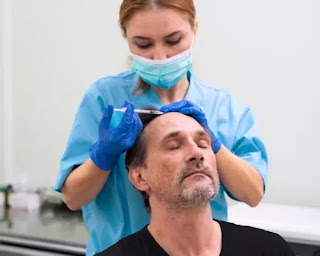Hair Transplantation - Head
Hair transplantation is a surgical procedure aimed at restoring hair growth in areas where hair loss or thinning has occurred. Primarily used to address male or female pattern baldness, this procedure involves transferring hair follicles from a donor area to the recipient bald or thinning areas on the scalp.
Understanding Hair Transplantation
Types of Hair Transplant Techniques:
Follicular Unit Transplantation (FUT):
Procedure: Strip harvesting, where a strip of scalp is removed from the donor area and dissected into grafts.
Grafting: Grafts containing hair follicles are transplanted into recipient sites. Scar: Leaves a linear scar in the donor area.
Follicular Unit Extraction (FUE):
Procedure: Individual follicular units are extracted from the donor area using a punch tool.
Grafting: The extracted follicular units are transplanted into the recipient sites.
Scar: Leaves tiny, dot-like scars scattered in the donor area.
Eligibility:
Suitable for individuals experiencing pattern baldness or hair thinning due to genetics.
Adequate donor hair availability from areas unaffected by baldness.
Procedure:
Preparation: The donor area is prepared, and local anesthesia is administered.
Extraction: Follicles are harvested from the donor area.
Recipient Site Creation: Tiny incisions are made in the recipient area.
Graft Placement: Individual follicular units are carefully placed into the recipient sites.
Post-Surgery Care: Aftercare instructions include avoiding strenuous activities, following a specific hair care regimen, and attending follow-up appointments.
Recovery and Results
Recovery Time: Initial recovery may take a few days to a week, with complete healing taking several weeks to months.
Results: Initial hair shedding is common, followed by new hair growth starting within a few months post-surgery.
Natural-Looking Hair: Gradual growth leads to natural-looking hair over time.
Considerations and Risks
Scarring: FUT leaves a linear scar, while FUE results in tiny, scattered scars.
Infection or Bleeding: Possible risks associated with any surgical procedure.
Shock Loss: Temporary shedding of existing hair around the transplant area.
Seeking Professional Guidance
Consultation with a qualified hair transplant specialist or dermatologic surgeon is essential. They evaluate candidacy, discuss expectations, and recommend the most suitable technique based on individual needs.
Embracing Hair Restoration
Hair transplantation offers a long-term solution to hair loss, providing natural-looking results and boosting confidence. Embracing this procedure involves understanding the process, setting realistic expectations, and seeking professional expertise to achieve successful and satisfying results. Remember, hair transplantation is a journey towards restored hair and enhanced self-confidence.



.jpeg)
Comments
Post a Comment